Exploring the slate industry around North Wales
Another fantastical adventure in Wales, starting with a spectacular train journey through the very heart of Wales, heading north along the Cymru coast to Criccieth. From here we follow the Welsh Highland railway cutting across the Lyn Peninsula and then hug coast of the Menai Straits (not a spelling mistake), across Thomas Telford’s Menai Suspension Bridge and onto Anglesea, home to the Druids of the ancient World. The next day it’s along the Ogwen Trail to Betws-y-coed, catching the train to Blaenau Ffestiniog. It’s a visit to the Llechwedd Slate Caverns before catching the slate train back to Porthmadog. Loads of castles, car free lanes and paths, I do love North Wales.
Day 1- Newport to Criccieth (Train)
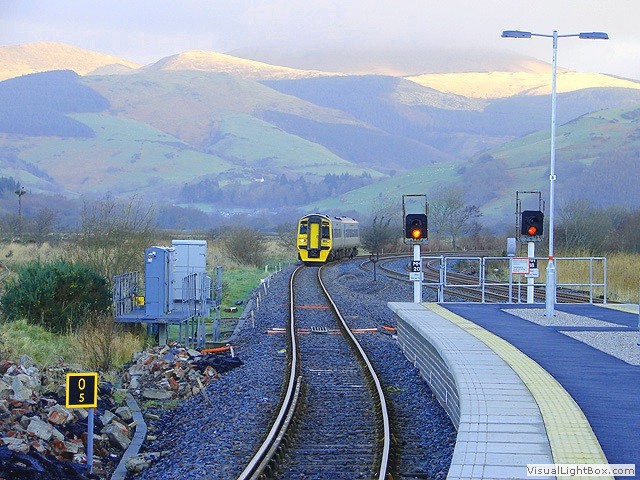
It’s quite a long train journey at five and a half hours, but I’m not in a rush. The train to Shrewsbury is always full so be sure to book a reservation for the bike. At Shrewsbury we change for the Cambrian Line, everybody should put this train journey on their bucket list, it truly is exceptional. The Cambrian Railway spans 120 miles of unspoilt natural beauty and is one of the most scenic rail routes in Britain. We travel through the rugged mountain terrain of the Cambrian mountains, through quaint market towns, World Heritage sites and past castles, cross country towards the picturesque West coast of Wales. Here it merges into the Cambrian Coastal route offering spectacular views along the length of the Gwynedd coast terminating at Pwllheli (via Criccieth).
Just to blow the cobwebs away I decided to disembark the train at Harlech and ride the last 10 miles to Criccieth. I wanted to see if the ice cream at Hufenfa'r Castell was as good as I thought it was in 2015, it was! After a ten minute taste sensation staring the imposing Harlech castle I jumped on the bike and headed along the B4573 and crossed Pont Briwet over the Afon Dwyryd. It’s a cup of tea in Porthmadog before cracking on to Criccieth. There’s no shortage of cafe’s in Criccieth as I make my way up an incline to the Marine Hotel my stop for tonight. I dropped the bike off and went straight out of the front door and climbed the mound to Criccieth castle, not the most ample of castles, but what a fantastic view.
Day 2- Criccieth to Beaumaris (33 miles)
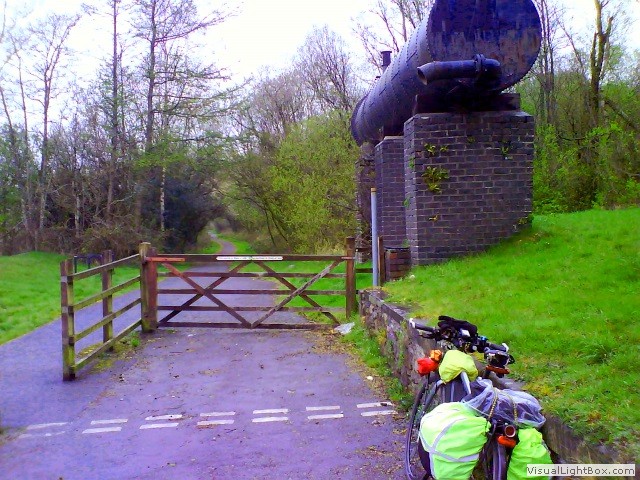 We're off to Anglesey today, the weather is overcast, cold and spitting rain. The first section of the
ride is on car free lanes passing Talhenbont Hall. The hall was built in 1607 and is
steeped in history, and once used as a Garrison for Cromwell’s army. The cycle path literally
passes through a farm then at Bryncir we turn onto the old London & North Western
railway line (LNWR), now called the 'Lôn Eifion trail'.
We're off to Anglesey today, the weather is overcast, cold and spitting rain. The first section of the
ride is on car free lanes passing Talhenbont Hall. The hall was built in 1607 and is
steeped in history, and once used as a Garrison for Cromwell’s army. The cycle path literally
passes through a farm then at Bryncir we turn onto the old London & North Western
railway line (LNWR), now called the 'Lôn Eifion trail'.
We passed Penygroes and stopped a little way on at ‘Inigo Jones Slate Works’. Founded in 1861 primarily to prefabricate school writing slates (can you imagine that), the company is still open today producing slate products. After a swift coffee at 'Café Gerlan', I took the Inigo Jones self guided tour (£5.50) around their factory, then it was on with the ride. At Llanwnda, is Dinas station, now part of the Welsh Highland railway (WHR), I just missed the northbound train and could hear it whistling away in the distance. This section of the railway between Caernarfon and Dinas was opened in 1877 by the 'London & North Western Railway' followed by a narrow gauge section south to Porthmadog. We now mirror the working line of the WHR, cycling on old railway routes may not be everyones cup of tea, but it does have its benefits; no roundabouts, steady gradients, peaceful, and no fopping cars, trucks, or buses to intimidate or gas you. I feel privileged to cross the Afan Seiont alongside the Welsh Highland Railway line, we alight the cycle path at Caernarfon then pass the magnificent Caernarfon Castle (I visited this on another ride click here here to read it).
 Once through Caernarfon, it’s not long before re-joining the old London & North
Western railway line, now the 'Lon Las Menai' cycle path. The
path is tree lined obliterating the view of the Menai Strait, accept for short patch's. We
proceed through Dinorwic Marina to connect with the B4547, heading for Treborth and the
Menai Suspension bridge. Crossing this stunning engineering icon is absolutely breathtaking, giving
way to a staggering vista. To the left we can just see Church island, the island is just
a huge graveyard with unknown origins, I believe some of the workmen who died during construction of
the Menai bridges are buried there. The bridge is the World's first iron suspension
bridge, and paved the way for others, it’s now a candidate for UNESCO World Heritage
status. We turned right and coasted down to Beach road and hugged a minor coast
road popping back up onto the main high street. Beaumaris is four miles from here
on a busy, fast, relatively narrow road, so be careful. Now late-afternoon, we headed
for Beaumaris gaol, alas it was just about to shut, but they let me in for free
for one photograph. I checked into the Bishopsgate House Hotel,
showered and trotted out to Beaumaris castle, too late to enter, but still good enough
light to photograph. It was a horrible day for riding, but a great day for site
seeing.
Once through Caernarfon, it’s not long before re-joining the old London & North
Western railway line, now the 'Lon Las Menai' cycle path. The
path is tree lined obliterating the view of the Menai Strait, accept for short patch's. We
proceed through Dinorwic Marina to connect with the B4547, heading for Treborth and the
Menai Suspension bridge. Crossing this stunning engineering icon is absolutely breathtaking, giving
way to a staggering vista. To the left we can just see Church island, the island is just
a huge graveyard with unknown origins, I believe some of the workmen who died during construction of
the Menai bridges are buried there. The bridge is the World's first iron suspension
bridge, and paved the way for others, it’s now a candidate for UNESCO World Heritage
status. We turned right and coasted down to Beach road and hugged a minor coast
road popping back up onto the main high street. Beaumaris is four miles from here
on a busy, fast, relatively narrow road, so be careful. Now late-afternoon, we headed
for Beaumaris gaol, alas it was just about to shut, but they let me in for free
for one photograph. I checked into the Bishopsgate House Hotel,
showered and trotted out to Beaumaris castle, too late to enter, but still good enough
light to photograph. It was a horrible day for riding, but a great day for site
seeing.
Day 3- Beaumaris to Betws-y-coed (35/48 miles), supposed to be train to Blaenau Ffestiniog
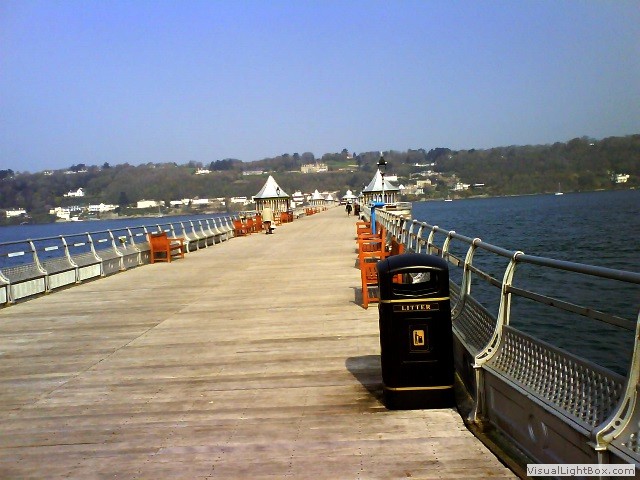 What a difference a day makes, today was sunny with a bracing breeze which left the far away mountains with a smoky haze.
We backtrack over the Menai bridge and head for Bangor. Once over the bridge we turn left through
Eithinog nature reserve across fields and grassland and past the Eisteddfod Gorsedd Stones
(stones laid in commemoration of a previous Eisteddfod) and to Garth pier Bangor. This Grade
II listed pier opened to the public in 1896 and was used to dock pleasure steamers of the
'Liverpool & North Wales Steamship Company' to and from Blackpool, Liverpool, and the Isle
of Man. It’s out toward Porth Penrhyn and onto Lôn Las Ogwen cycle path which climbs one thousand feet
in eleven miles. The cycle path turns south and gently climbs through a mature broadleaf
woodland following the Afon Cegin. After yesterday, this feels like ‘how riding the bike
should be’. Warm enough for shorts, quiet except for the sound of birds and the babbling stream, it was really nice.
At Tregarth Park we go through the recently renovated 2,600 feet railway tunnel between Tregarth
and Bethesda emerging to another small viaduct and terminating at Coetmor Mill.
What a difference a day makes, today was sunny with a bracing breeze which left the far away mountains with a smoky haze.
We backtrack over the Menai bridge and head for Bangor. Once over the bridge we turn left through
Eithinog nature reserve across fields and grassland and past the Eisteddfod Gorsedd Stones
(stones laid in commemoration of a previous Eisteddfod) and to Garth pier Bangor. This Grade
II listed pier opened to the public in 1896 and was used to dock pleasure steamers of the
'Liverpool & North Wales Steamship Company' to and from Blackpool, Liverpool, and the Isle
of Man. It’s out toward Porth Penrhyn and onto Lôn Las Ogwen cycle path which climbs one thousand feet
in eleven miles. The cycle path turns south and gently climbs through a mature broadleaf
woodland following the Afon Cegin. After yesterday, this feels like ‘how riding the bike
should be’. Warm enough for shorts, quiet except for the sound of birds and the babbling stream, it was really nice.
At Tregarth Park we go through the recently renovated 2,600 feet railway tunnel between Tregarth
and Bethesda emerging to another small viaduct and terminating at Coetmor Mill.
The Google route would take you onto the B4409, but I carried onto Bethesda
past Bethesda Rugby club, and there can’t be many clubs with as beautiful vista as this, as the
panorama opens up to the snow capped mountains of Snowdonia. At Coed-y-parc the route
has a dramatic change of scenery as we travel through the spoils of Penrhyn slate quarry.
You can certainty feel the
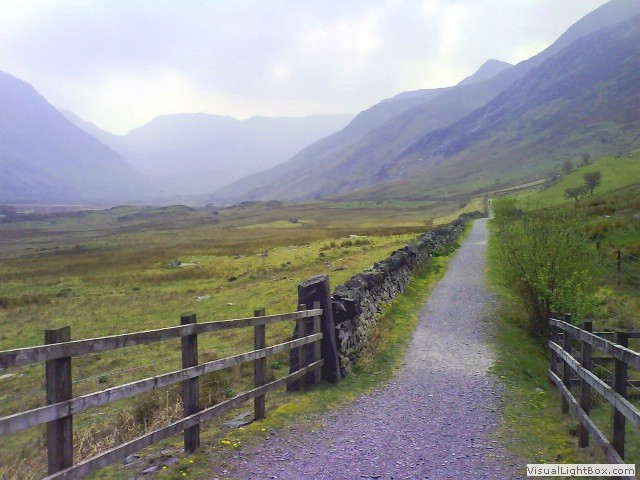 height with colder temperatures and the massive mountains getting closer. Ogwen valley is so
beautiful as we pass Snowdonia Mountain Hostel with not another building in sight climbing
higher every pedal revolution. It’s certainly one of the most breathtaking views I’ve seen in
a while (click the image for bigger view), but the view filled me with trepidation as
I’m not a ‘mountain billy goat’. I stopped and asked
a walker, “is the route ahead do-able on a bike with panniers and a big
belly owner riding it?” He smiled and said, “it’s better this way, but it can be done, just take your time.”
With that, off I snorted, climbing and walking, walking and climbing to the top at Pont
Pen-y-benglog. Here the track ends at Ogwen Snack Bar, where I joined hundreds of people,
dogs, kids, and two Nuns. Every man and his dog was here, transported by a herd of
coaches, mini buses, cars and two motorbikes (probably belonging to the
nuns). I sat on a wall dripping in a bath of sweat, while the
‘normal people’ stared at me in bewilderment over their pistachio ice-creams.
height with colder temperatures and the massive mountains getting closer. Ogwen valley is so
beautiful as we pass Snowdonia Mountain Hostel with not another building in sight climbing
higher every pedal revolution. It’s certainly one of the most breathtaking views I’ve seen in
a while (click the image for bigger view), but the view filled me with trepidation as
I’m not a ‘mountain billy goat’. I stopped and asked
a walker, “is the route ahead do-able on a bike with panniers and a big
belly owner riding it?” He smiled and said, “it’s better this way, but it can be done, just take your time.”
With that, off I snorted, climbing and walking, walking and climbing to the top at Pont
Pen-y-benglog. Here the track ends at Ogwen Snack Bar, where I joined hundreds of people,
dogs, kids, and two Nuns. Every man and his dog was here, transported by a herd of
coaches, mini buses, cars and two motorbikes (probably belonging to the
nuns). I sat on a wall dripping in a bath of sweat, while the
‘normal people’ stared at me in bewilderment over their pistachio ice-creams.
It’s now on the main road past the Lyn Ogwen reservoir, here I was due to ride to Capel Curig on an old Byway. Time was ticking and if I took that route I would almost certainly miss my train at Betws-y-coed, so I stayed on the main road, but it wouldn’t be cricket, if I didn’t visit 'Swallow Falls Waterfall' on the way down. I managed to lock the bike up in the Betws-y-coed YHA, changed out of my cycling shoes and trotted down the greasy rocky steps via a turnstile (£2) to a viewing platform. Set in a picturesque, wooded setting, not exactly Niagara falls, but all waterfalls tend to have calming, aesthetic qualities about them (not that I need calming down after 32 miles on the bike, but I wouldn’t say no to some aesthetic on my arse), and I suppose they prove humans can’t tame nature, so it was worth a peek.
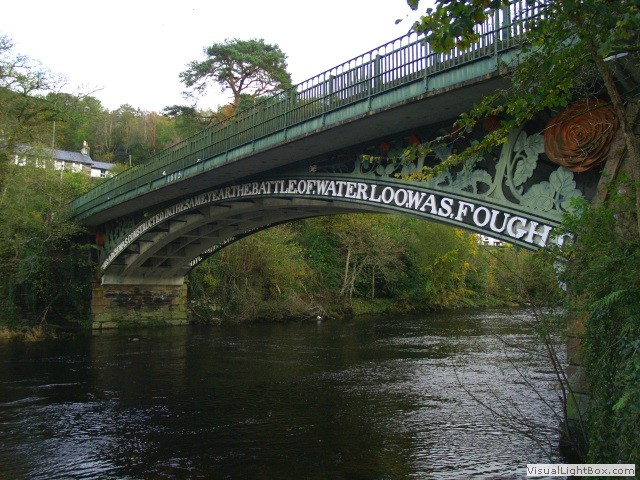 Betws-y-coed is one of the biggest tourist honeypot traps in Snowdonia, and was founded around
a monastery in the late sixth century (maybe that's where the Nuns came from). The village
grew very slowly with the development of the local lead mining industry. Today the place was
teeming with tourists, they were everywhere. I planned to end the ride here, have a nice bite
to eat (preferably an Italian meal with a splash of garlic, maybe a glass of red wine) and
catch the train to Blaenau Ffestiniog. ‘The best-laid plans of mice and men often go awry’.
The train tracks to Blaenau had washed away two weeks ago and the replacement buses didn’t take bikes. It was now
four o’clock, baking heat, and Blaenau Ffestiniog was thirteen miles away. After thirty five
miles, I wasn’t prepared for this extra mileage. In jealously, I almost spat at the beer swilling tourists
as I rode off again cussing and cursing under my breath. Worse still, I had to go over and
through the Crimea Pass, a massive 7 mile climb near Blaenau Ffestiniog (quoted in the
hill climbers guide to North Wales). Near the top, I decided to
use a free anti-latic acid gel, it tasted like menthol flavoured washing
up liquid and had me pulling faces like eating raw garlic (yes I have). I finally arrived in Blaenau Ffestiniog and was
staying at the Pisgah B&B, named after Capel Pisgah (Pisgah Chapel) built in 1899 as a
place of worship for the slate miners and their families. It wasn’t
until I had a shower, then re-read the 'Pro endurance gel' packet, only to discover
the gel was to rub on my legs, not to drink.
Betws-y-coed is one of the biggest tourist honeypot traps in Snowdonia, and was founded around
a monastery in the late sixth century (maybe that's where the Nuns came from). The village
grew very slowly with the development of the local lead mining industry. Today the place was
teeming with tourists, they were everywhere. I planned to end the ride here, have a nice bite
to eat (preferably an Italian meal with a splash of garlic, maybe a glass of red wine) and
catch the train to Blaenau Ffestiniog. ‘The best-laid plans of mice and men often go awry’.
The train tracks to Blaenau had washed away two weeks ago and the replacement buses didn’t take bikes. It was now
four o’clock, baking heat, and Blaenau Ffestiniog was thirteen miles away. After thirty five
miles, I wasn’t prepared for this extra mileage. In jealously, I almost spat at the beer swilling tourists
as I rode off again cussing and cursing under my breath. Worse still, I had to go over and
through the Crimea Pass, a massive 7 mile climb near Blaenau Ffestiniog (quoted in the
hill climbers guide to North Wales). Near the top, I decided to
use a free anti-latic acid gel, it tasted like menthol flavoured washing
up liquid and had me pulling faces like eating raw garlic (yes I have). I finally arrived in Blaenau Ffestiniog and was
staying at the Pisgah B&B, named after Capel Pisgah (Pisgah Chapel) built in 1899 as a
place of worship for the slate miners and their families. It wasn’t
until I had a shower, then re-read the 'Pro endurance gel' packet, only to discover
the gel was to rub on my legs, not to drink.
Day 4- Blaenau Ffestiniog to Porthmadog (slate train)
Blaenau Ffestiniog has long been known as 'the town that roofed the World', and the Borough is immensely proud of its industrial heritage. From a cluster of farms, a number of slate quarries were opened and a bustling town grew. I’ve been here before, but it didn’t prepare me for the enchanting rugged beauty of the place. Today the town centre is struggling as many are and it seems like Blaenau Ffestiniog is a day trippers town (come here for the day and then go back), the problem with that is people don’t spend the money, so there's little to re-invest. I can’t believe how bustling Betws-y-coed is just a few miles away compared to Blaenau Ffestiniog. There’s so much to do and see here, I will have to come back (and maybe ride the Byway I had to miss from Lyn Ogwen reservoir down). My legs are still screaming after yesterday, so I’m glad today is off the bike. I'm visiting Llechwedd Slate quarry which opened in 1846, the Victorians worked the area hard, but only wanted roofing slate which wasted 95% of the material. Today they concentrate on recycling what the Victorians left behind, though Llechwedd Slate quarry is more famous for their tourist attractions; zip lines and the caverns. I’m going to visit Llechwedd Slate Caverns today and do the Slate Mountain Adventure (Llechwedd Combined Ticket £30).
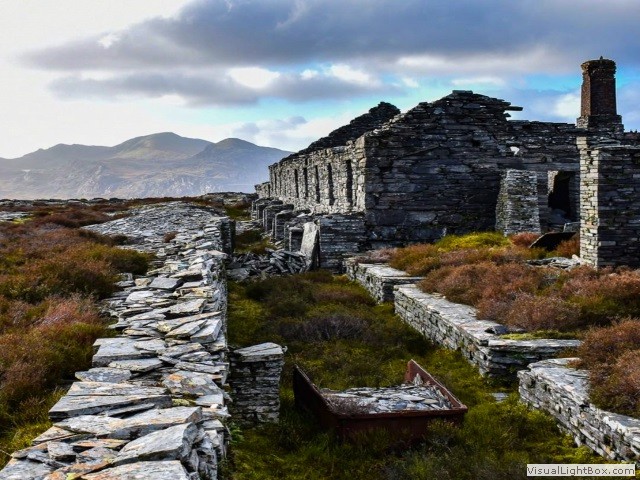 We started the tour on an old army truck that rumbled us up to the top of the
mountain, from this fabulous vantage point we could see the whole slate quarry. The
scale of this quarry alone is immense and the workers had to be at their
stations on time everyday without company transport, sometimes taking an
hour to walk up the mountain. The seams of slate went diagonal so the
operation continued underground, so the tour descended on the steepest cable railway in Britain,
dropping 500 feet down to the mine. Once underground there is a sense of foreboding as
we walked into the dark passages into the very bowels of the earth. There, on an
interactive display the old mine owner was introduced, the video explained how men
and boys spent up to twelve hours a day, six days a week, working underground in
virtual darkness. Our guide showed us how they hand drilled the slate working
at height only supported by a chain wrapped around their one leg, then they
pushed home-made fuses into the holes and lit them. The blast timing was unpredictable and many died doing the job.
We walked through a series of gargantuan man made caves, the last colossal cavern
had a lake and a magic light/ sound show. We finished the tour at ground
level in the mill where the process of cutting slate was
interestingly explained and then finished with a walk around the small
Victorian village. Life was harsh in the quarries and mines, but the common man had
little or no-choice but to work here.
We started the tour on an old army truck that rumbled us up to the top of the
mountain, from this fabulous vantage point we could see the whole slate quarry. The
scale of this quarry alone is immense and the workers had to be at their
stations on time everyday without company transport, sometimes taking an
hour to walk up the mountain. The seams of slate went diagonal so the
operation continued underground, so the tour descended on the steepest cable railway in Britain,
dropping 500 feet down to the mine. Once underground there is a sense of foreboding as
we walked into the dark passages into the very bowels of the earth. There, on an
interactive display the old mine owner was introduced, the video explained how men
and boys spent up to twelve hours a day, six days a week, working underground in
virtual darkness. Our guide showed us how they hand drilled the slate working
at height only supported by a chain wrapped around their one leg, then they
pushed home-made fuses into the holes and lit them. The blast timing was unpredictable and many died doing the job.
We walked through a series of gargantuan man made caves, the last colossal cavern
had a lake and a magic light/ sound show. We finished the tour at ground
level in the mill where the process of cutting slate was
interestingly explained and then finished with a walk around the small
Victorian village. Life was harsh in the quarries and mines, but the common man had
little or no-choice but to work here.
When investigating my route for the last few days I came across the ‘Rhiwbach Tramway’ and I wanted to know if it was ridable. The Rhiwbach Tramway was a narrow gauge railway connecting the remote slate quarries east of Blaenau Ffestiniog with the Ffestiniog Railway. So, on the way back from the Llechwedd caverns I popped into ‘Antur Stiniog’ (a mountain bike centre of excellence) and enquired about the old tramway. I had another question- due to its remoteness, were any guides available in the future to do the ride with me? The people were great and gave me some cracking information, they also mentioned their Velorail project which is basically a converted railway carriage bogie that runs on an existing railway then a few people cycle on it to move it forward. The Velorail was intended to go from Blaenau Ffestiniog to Trawsfynydd, but wasn’t totally lucrative yet, so only goes part of the way. After coming home and looking at old maps, the axed Great Western railway trackbed continues from Blaenau Ffestiniog via Trawsfynydd and proceeds most of the way to Bala and it looks ridable (on a mountain bike). Another two rides in the bank for the future.
I’d booked the afternoon slate train back to Porthmadog and eagerly awaited its arrival. The bike was stowed and I took my seat in the first class carriage (after all I’m unlikely to repeat this experience soon). The route is defiantly bumpier and wobblier than the Welsh Highland Railway, but the views are just as beautiful and I couldn’t believe how close to the walls we went. A must to do in the area.
Day 5- Porthmadog to Newport (train)
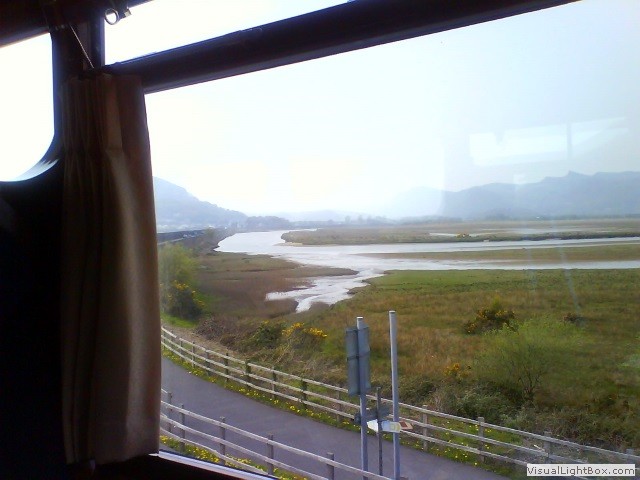 Porthmadog was the choice port to export slate around the World and domestically around Britain. Since the decline
of the industry it has become a tourist destination, and what a little gem it is. The town
is dominated on one side by the ‘Moel y Gest' mountain and the North and East is the wide
expanse of the Glaslyn estuary, such an alluring setting. Most of the railway paths we have
ridden in the past are associated with defunct collieries, North Wales is riddled with slate
quarries and their transport routes and it’s been thoroughly enjoyable plodding along them.
We’ve passed loads of castles and slate quarries set in a backdrop of the beautiful Snowdonia
National park. Over four years ago, I ate breakfast at the Ffestiniog & Welsh Highland
Railway main station, before I step on the train to go back home I’m going to repeat that
experience. This hasn’t so much been about riding the bike, it’s been about exploring and
seeking information about my country's history. I leave the place with a sense of
incompleteness, there’s so much more to investigate in North
Wales and I haven't got enough time to conclude the expedition, but surely that's the magnetism
of discovery. I can’t wait to come back.
Porthmadog was the choice port to export slate around the World and domestically around Britain. Since the decline
of the industry it has become a tourist destination, and what a little gem it is. The town
is dominated on one side by the ‘Moel y Gest' mountain and the North and East is the wide
expanse of the Glaslyn estuary, such an alluring setting. Most of the railway paths we have
ridden in the past are associated with defunct collieries, North Wales is riddled with slate
quarries and their transport routes and it’s been thoroughly enjoyable plodding along them.
We’ve passed loads of castles and slate quarries set in a backdrop of the beautiful Snowdonia
National park. Over four years ago, I ate breakfast at the Ffestiniog & Welsh Highland
Railway main station, before I step on the train to go back home I’m going to repeat that
experience. This hasn’t so much been about riding the bike, it’s been about exploring and
seeking information about my country's history. I leave the place with a sense of
incompleteness, there’s so much more to investigate in North
Wales and I haven't got enough time to conclude the expedition, but surely that's the magnetism
of discovery. I can’t wait to come back.
-
Gallery
 Why not have a look at the gallery relating to this ride. Click the image or the title.
Why not have a look at the gallery relating to this ride. Click the image or the title. -
Barmouth bridge
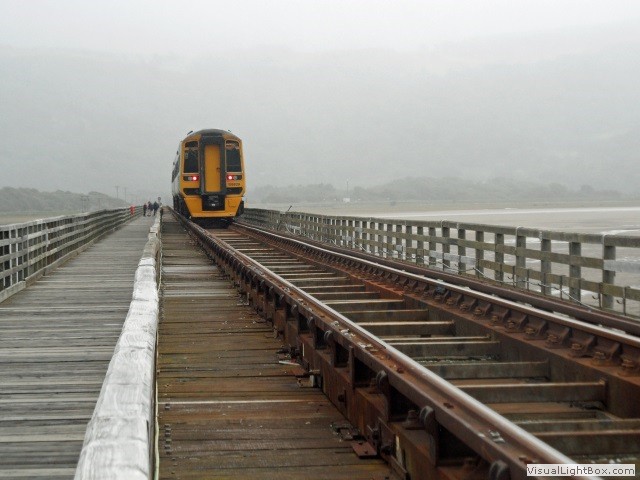 The wooden structure, built in 1867 has survived two World wars and a bout of
woodworm. In 2017 the grade I listed bridge obtained a £20m grant to secure its future.
The wooden structure, built in 1867 has survived two World wars and a bout of
woodworm. In 2017 the grade I listed bridge obtained a £20m grant to secure its future. -
Cricceth castle
 Cricceth castle’s allegiance swapped so many times between the English and Welsh, the
history books have lost count. It’s spectacular, eminent position clearly demonstrates the strategic
benefit it had overlooking Tremadog Bay.
Cricceth castle’s allegiance swapped so many times between the English and Welsh, the
history books have lost count. It’s spectacular, eminent position clearly demonstrates the strategic
benefit it had overlooking Tremadog Bay. -
London & North Western railway line
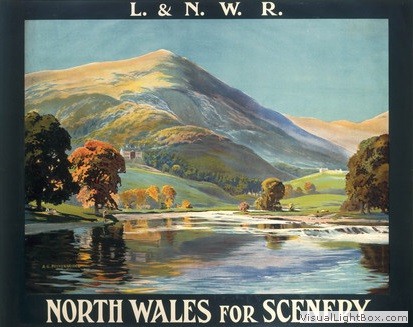 The Bangor to Afon Wen line lasted to the mid sixties finally closing under the axe.
The Bangor to Afon Wen line lasted to the mid sixties finally closing under the axe. -
Caernarfon Castle
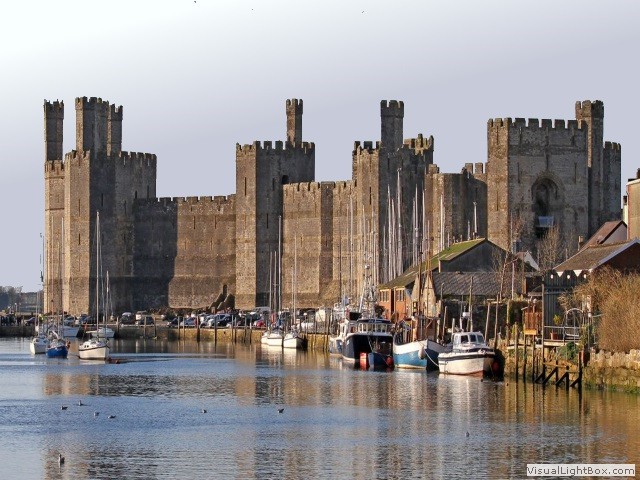 A brute of a fortress. Caernarfon Castle’s pumped-up appearance is unashamedly muscle-bound and
intimidating. Picking a fight with this massive structure would have been a daunting prospect. By
throwing his weight around in stone, King Edward I created what is surely one of the most impressive
Welsh castles.
A brute of a fortress. Caernarfon Castle’s pumped-up appearance is unashamedly muscle-bound and
intimidating. Picking a fight with this massive structure would have been a daunting prospect. By
throwing his weight around in stone, King Edward I created what is surely one of the most impressive
Welsh castles. -
Telford’s Menai Suspension Bridge
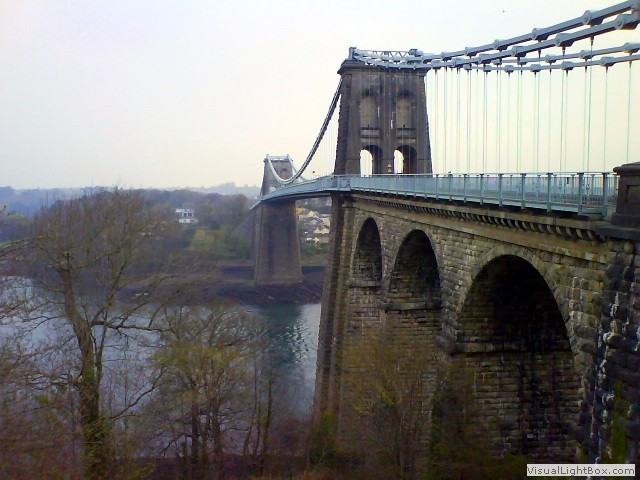 Thomas Telford’s Menai Suspension Bridge is indeed a marvel of engineering and was completed in
1826. Though ample for the day, it was soon found the wooden roadway proved unstable in high winds
and had to strengthened. With modern motor vehicles heavier than previous traffic, in 1938 the
original wrought iron chains had to be replaced with steel ones. Sixty years later the bridge
had to be restrengthened again, but this bridge still demands respect as we can easily forget;
it's approaching 200 years old.
Thomas Telford’s Menai Suspension Bridge is indeed a marvel of engineering and was completed in
1826. Though ample for the day, it was soon found the wooden roadway proved unstable in high winds
and had to strengthened. With modern motor vehicles heavier than previous traffic, in 1938 the
original wrought iron chains had to be replaced with steel ones. Sixty years later the bridge
had to be restrengthened again, but this bridge still demands respect as we can easily forget;
it's approaching 200 years old. -
Welsh paddle steamers
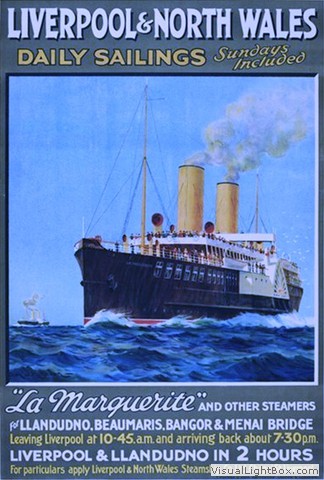 The Liverpool & North Wales Steamship Company was formed in 1892 and thrived
running paddle steamers along North Wales and through the Menai straits for over seventy
years closing in 1962. A reincorporated Liverpool & North Wales Steam Ship Company Ltd opened
in 2016, the company aims to recreate the era of sea travel in the 1950's.
The Liverpool & North Wales Steamship Company was formed in 1892 and thrived
running paddle steamers along North Wales and through the Menai straits for over seventy
years closing in 1962. A reincorporated Liverpool & North Wales Steam Ship Company Ltd opened
in 2016, the company aims to recreate the era of sea travel in the 1950's. -
The Great Strike of Penrhyn Quarry
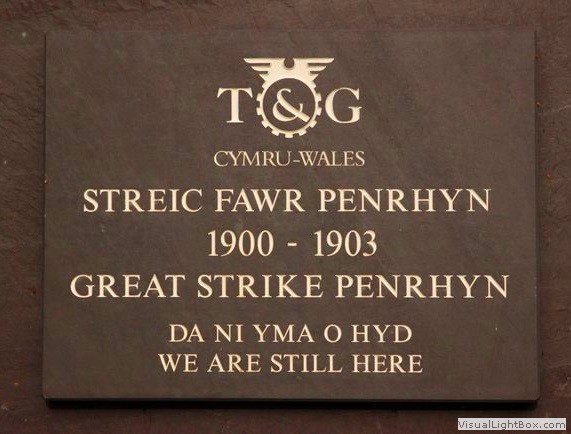 In 1900, Penrhyn Quarry was at the centre of one of the largest disputes ever seen in the history
of industrial Britain. Tensions were running high between nearly 3,000 quarrymen
and the owner Lord Penrhyn after he prohibited future union
influence and allocated ‘banks’ of slate to specific workers. This led to assaults on contractors who had
struck the bargain, Lord Penrhyn pressed assault charges against twenty six quarrymen and they were summarily dismissed,
even before their case was heard at the Magistrates Court.
In 1900, Penrhyn Quarry was at the centre of one of the largest disputes ever seen in the history
of industrial Britain. Tensions were running high between nearly 3,000 quarrymen
and the owner Lord Penrhyn after he prohibited future union
influence and allocated ‘banks’ of slate to specific workers. This led to assaults on contractors who had
struck the bargain, Lord Penrhyn pressed assault charges against twenty six quarrymen and they were summarily dismissed,
even before their case was heard at the Magistrates Court.
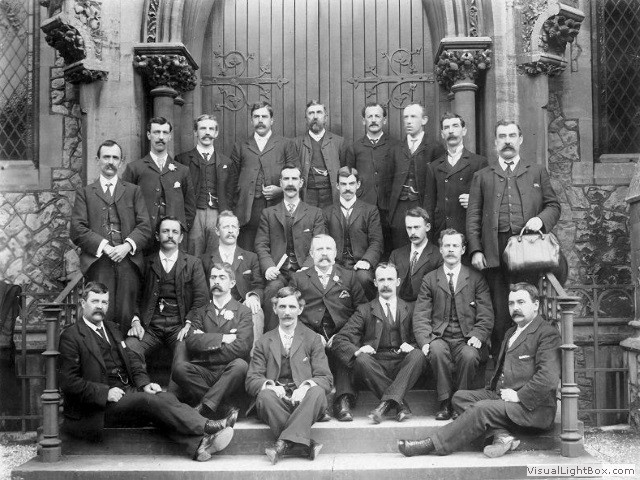 Eight hundred men marched to court to show support and
they too were instantly suspended, at the hearing twenty of the accused men were found not guilty of the
charges. Three days later, 2,000 quarrymen refused to work until the other 820 were allowed back to
work. That morning an ultimatum was given to the remaining men- “Go on working or leave the quarry”.
Eight hundred men marched to court to show support and
they too were instantly suspended, at the hearing twenty of the accused men were found not guilty of the
charges. Three days later, 2,000 quarrymen refused to work until the other 820 were allowed back to
work. That morning an ultimatum was given to the remaining men- “Go on working or leave the quarry”.
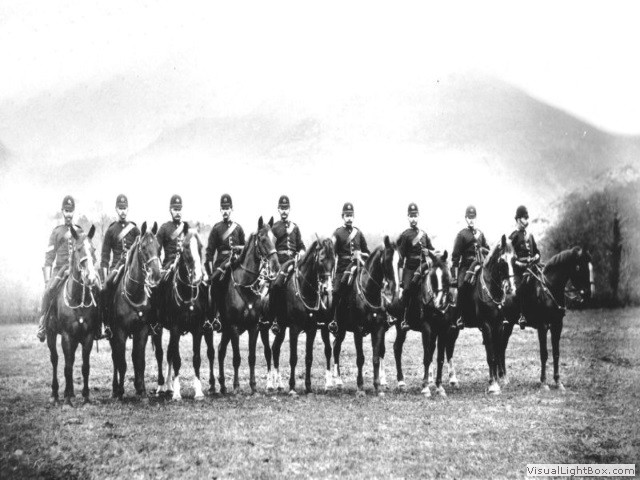 They walked out marking the beginning of the Great Strike of Penrhyn. Soon afterwards the Chief
Constable of Caernarfonshire sent troops into the village and a Justice of the Peace arrived to read
the ‘Riot Act’ to the striking men, formally warning the protesters to disperse and authorising the
use of force if necessary. Three years later less than 40% of the men went back to work.
They walked out marking the beginning of the Great Strike of Penrhyn. Soon afterwards the Chief
Constable of Caernarfonshire sent troops into the village and a Justice of the Peace arrived to read
the ‘Riot Act’ to the striking men, formally warning the protesters to disperse and authorising the
use of force if necessary. Three years later less than 40% of the men went back to work. -
North Wales Crimea pass
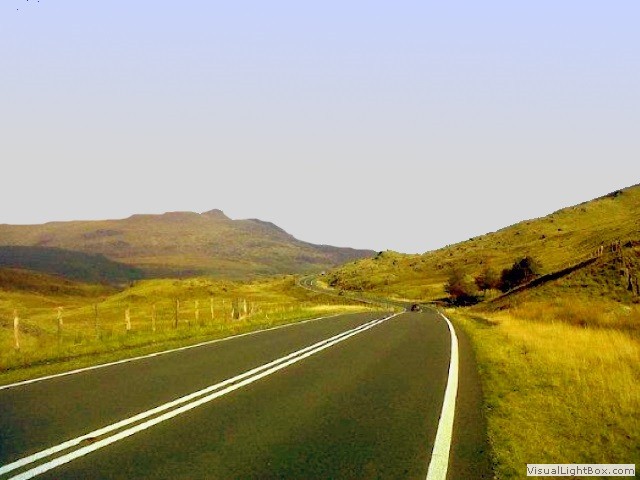 The road was opened, in 1854 when Crimean War was being fought. By repute construction of the
stone walls in the area was carried out by Russian prisoners of war captured at the Battles of
Inkerman and Balaclava.
The road was opened, in 1854 when Crimean War was being fought. By repute construction of the
stone walls in the area was carried out by Russian prisoners of war captured at the Battles of
Inkerman and Balaclava. -
Blaenau Ffestiniog
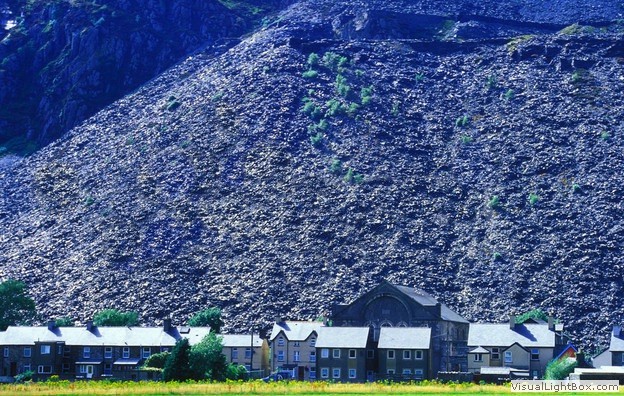 Blaenau Ffestiniog looks as though it is situated in the epicentre of an enormous explosion. The town
crouches below mountains of slate waste which drop down to the residents back yards. Only a tiny red
and green quarry locomotive mounted on a slate plinth, hint at the history of a place, where men worked
for three shillings a day for the gentry quarry owners, who built mansions and even castles, on the
fortunes of the slate.
Blaenau Ffestiniog looks as though it is situated in the epicentre of an enormous explosion. The town
crouches below mountains of slate waste which drop down to the residents back yards. Only a tiny red
and green quarry locomotive mounted on a slate plinth, hint at the history of a place, where men worked
for three shillings a day for the gentry quarry owners, who built mansions and even castles, on the
fortunes of the slate. -
Rhiwbach tramway
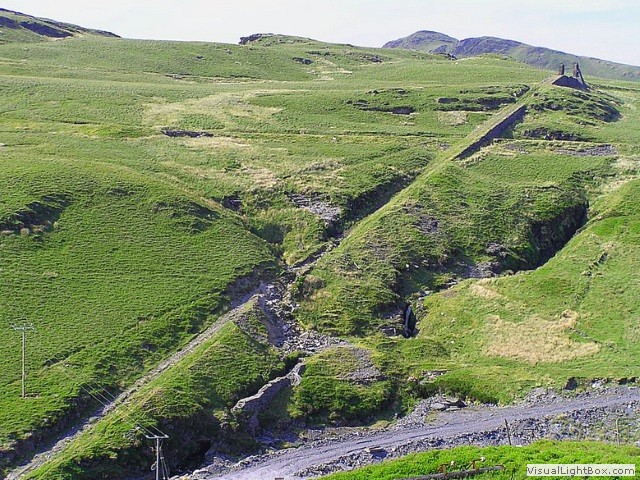 Construction of the three mile tramway began in 1861 and opened in 1863, the railway had several
(4) inclines. The incline at the Rhiwbach end was unusual as it was used to raise loaded waggons
from the quarry's mill level to that of the tramway. As this worked against gravity the incline
was steam-powered. Above No.3 incline the tramway is in good condition though can easily become
water logged and forms part of a three mile walk.
Construction of the three mile tramway began in 1861 and opened in 1863, the railway had several
(4) inclines. The incline at the Rhiwbach end was unusual as it was used to raise loaded waggons
from the quarry's mill level to that of the tramway. As this worked against gravity the incline
was steam-powered. Above No.3 incline the tramway is in good condition though can easily become
water logged and forms part of a three mile walk. -
The Rhiwbach during WW2
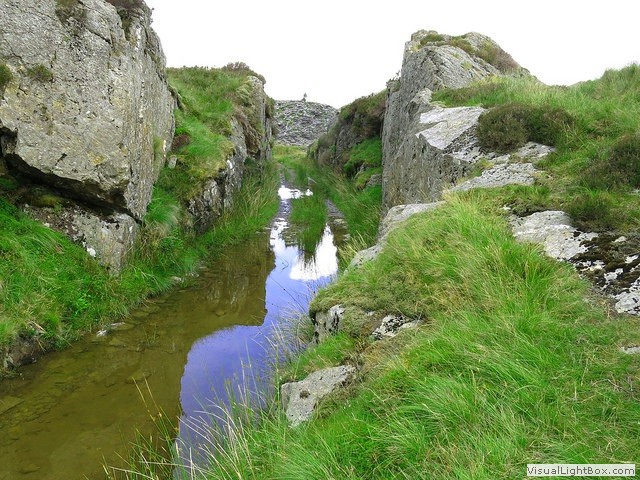 "Hide them in caves and cellars, but not one picture shall leave this island." (Winston
Churchill, 1940). The Rhiwbach narrow-gauge tramway was built by the Ffestiniog Railway Company in
1861 and during WW2, it was these rails that carried priceless works of art to their
safe haven deep underground.
"Hide them in caves and cellars, but not one picture shall leave this island." (Winston
Churchill, 1940). The Rhiwbach narrow-gauge tramway was built by the Ffestiniog Railway Company in
1861 and during WW2, it was these rails that carried priceless works of art to their
safe haven deep underground. -
Nant Prysor Viaduct
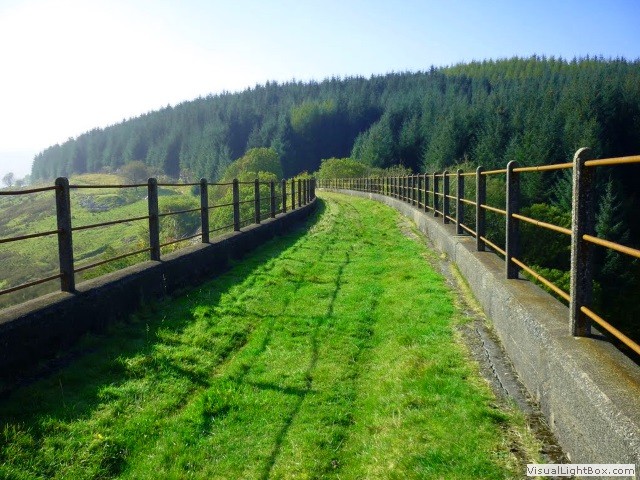 Nant Prysor Viaduct was built in 1882, and was part of the Blaenau Ffestiniog to Bala
railway line, which closed in 1961. Reading some blogs most of the route is ridable, but
boggy, so it’s a good weather ride again.
Nant Prysor Viaduct was built in 1882, and was part of the Blaenau Ffestiniog to Bala
railway line, which closed in 1961. Reading some blogs most of the route is ridable, but
boggy, so it’s a good weather ride again. -
The other 'Black Gold'
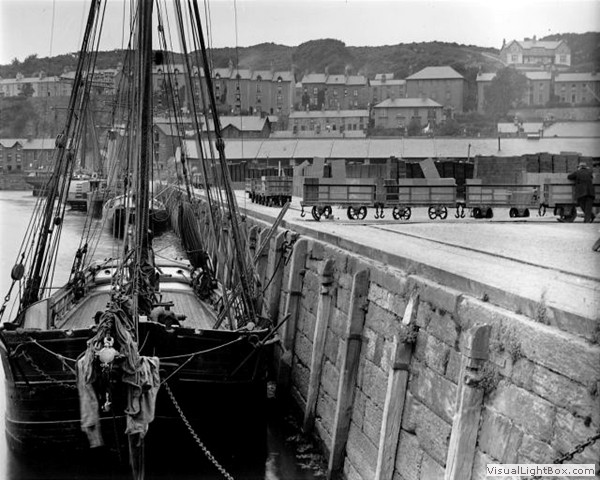 At 500 million years old, North Wales had a indigenous material that was widely recognised as the
finest in the World. Still haven’t guessed what it is? Well then, if South Wales is synonymous with
coal, then North Wales has been equally blessed and cursed with its equivalent - Slate. At the end
of the 18th century, however, that demand for the material exploded, changing the look and life of
North Wales forever. Slate is now back in fashion, though once a cheap sustainable material, now
it costs a pretty penny compared to man-made materials.
At 500 million years old, North Wales had a indigenous material that was widely recognised as the
finest in the World. Still haven’t guessed what it is? Well then, if South Wales is synonymous with
coal, then North Wales has been equally blessed and cursed with its equivalent - Slate. At the end
of the 18th century, however, that demand for the material exploded, changing the look and life of
North Wales forever. Slate is now back in fashion, though once a cheap sustainable material, now
it costs a pretty penny compared to man-made materials.
